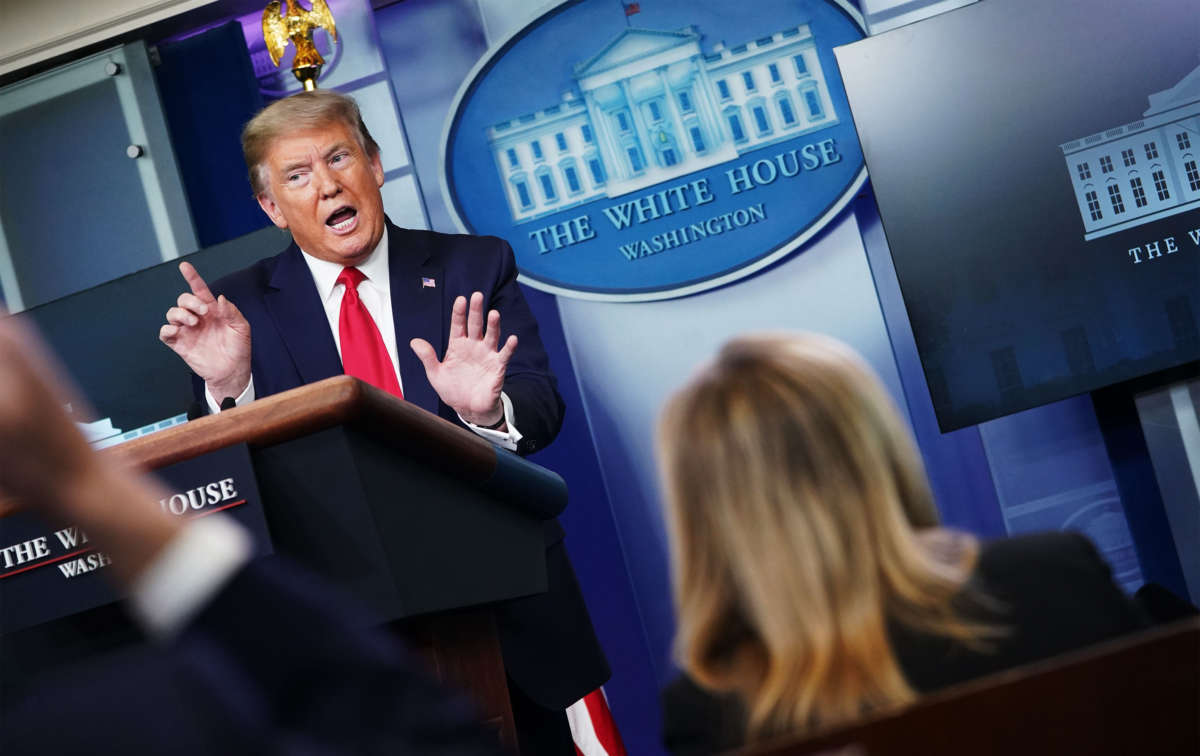Support justice-driven, accurate and transparent news — make a quick donation to Truthout today!
President Donald Trump featured a video produced by the White House at a press briefing on Monday during which he took on a decidedly defensive tone toward reporters and the media in general over his slow response to the spread of COVID-19 in the U.S.
The video, which some have described as being propagandistic, featured selected news clips and reports from media that put Trump’s actions during the crisis in a positive tone. Yet, there were glaring problems with the video, which reporters noted both during the press conference and in reporting later on.
One of the biggest issues was the selective editing that was taken to produce parts of the video, which cast the president as responding adequately, contrary to what some of the original media clips intended to portray. In one clip, for example, New York Times reporter Maggie Haberman’s voice is heard, as she was recorded during a podcast earlier this year describing some of the administration’s actions during the first month of the crisis.
Discussing Trump’s decision to close travel from China in January, Haberman said in that podcast, “At the end of the day, it was probably effective, because it did actually take a pretty aggressive measure against the spread of the virus.”
The clip seems to suggest that media were supportive or happy with his response to COVID-19’s spread in the U.S. after that action took place. But the recording provided by the White House omits the very next sentence from Haberman’s podcast.
“The problem is, it was one of the last things that he did for several weeks,” she said.
Indeed, the video, which was constructed as a timeline of events of actions Trump and his administration had taken from January to April, had another glaring omission: almost all of the month of February was missing from the timeline itself, during which the White House made very little, if any, decisive moves to prepare for the disease’s impending spread.
CBS News White House correspondent Paula Reid attempted to ask the president about the “gap” that was noticeable in the video. Trump wasn’t having it.
Reid started out by asking what good stopping travel from China did if no actions were taken immediately after it.
“The argument is that you bought yourself some time. You didn’t use it to prepare hospitals, you didn’t use it to ramp up testing,” Reid began.
Trump interrupted her at that point, perhaps trying to disrupt her line of questioning. “Nobody thought we should do it, and when I did it —”
Reid didn’t let up. “But what did you do with the time that you bought? The month of February?” she asked.
President Donald J Trump calms a nation on edge pic.twitter.com/HO6Ou1XJzg
— Andrew Lawrence (@ndrew_lawrence) April 13, 2020
The president continued to argue against her line of questioning, pointing out that the United States had zero cases and zero deaths from the disease in mid-January, totally ignoring the point of Reid’s question.
When Reid once again noted that she was asking about February, and how the video “has a complete gap” during that month, Trump went on the attack against her character and her network’s reputation.
“You know you’re a fake, you know that? Your whole network, the way you cover it is fake,” he responded.
Trump continued to insist that the way he reacted to the disease was perfect. “We really have done this right. The problem is the press doesn’t cover it the way it should be,” he added.
February is indeed a controversial time for Trump, as he spent much of the month downplaying the threat from COVID-19 to the nation.
On February 19, for instance, Trump suggested that the virus would go away with warmer temperatures, insinuating there was no need to raise questions about what should be done.
“I think when we get into April, in the warmer weather, that has a very negative effect on that and that type of a virus. So let’s see what happens, but I think it’s going to work out fine,” he said.
On February 26, amid growing criticisms that he wasn’t acting in a way that reflected health experts’ concerns, the president said the number of cases (at that time, reported to be around 15), was “going to be down to close to zero” within a matter of days. “That’s a pretty good job we’ve done,” Trump added.
And on February 28, during a campaign rally in South Carolina, Trump accused Democrats of trying to politicize the disease in order to make him look bad. “This is their new hoax,” he said that evening.
Trump continued to downplay the seriousness of the disease into March, but changed his tone when it was clear the disease wasn’t as innocuous as he had insisted it was. On March 13, he finally declared a national emergency.
As of 10:30 a.m. Eastern Time on Tuesday — 48 days after he said the number of cases would be close to zero within a short period of time — there are more than 582,000 confirmed cases of COVID-19 within the United States, including nearly 24,000 recorded deaths so far.
Press freedom is under attack
As Trump cracks down on political speech, independent media is increasingly necessary.
Truthout produces reporting you won’t see in the mainstream: journalism from the frontlines of global conflict, interviews with grassroots movement leaders, high-quality legal analysis and more.
Our work is possible thanks to reader support. Help Truthout catalyze change and social justice — make a tax-deductible monthly or one-time donation today.
